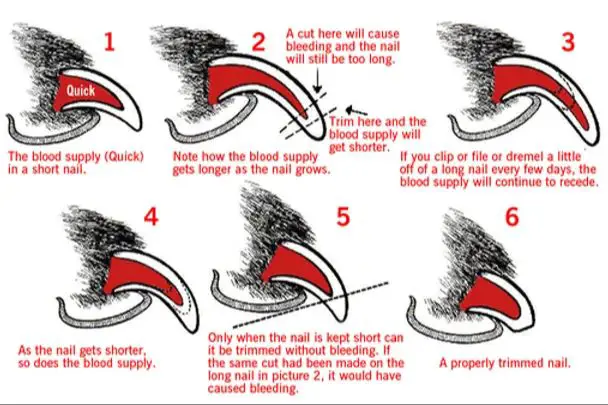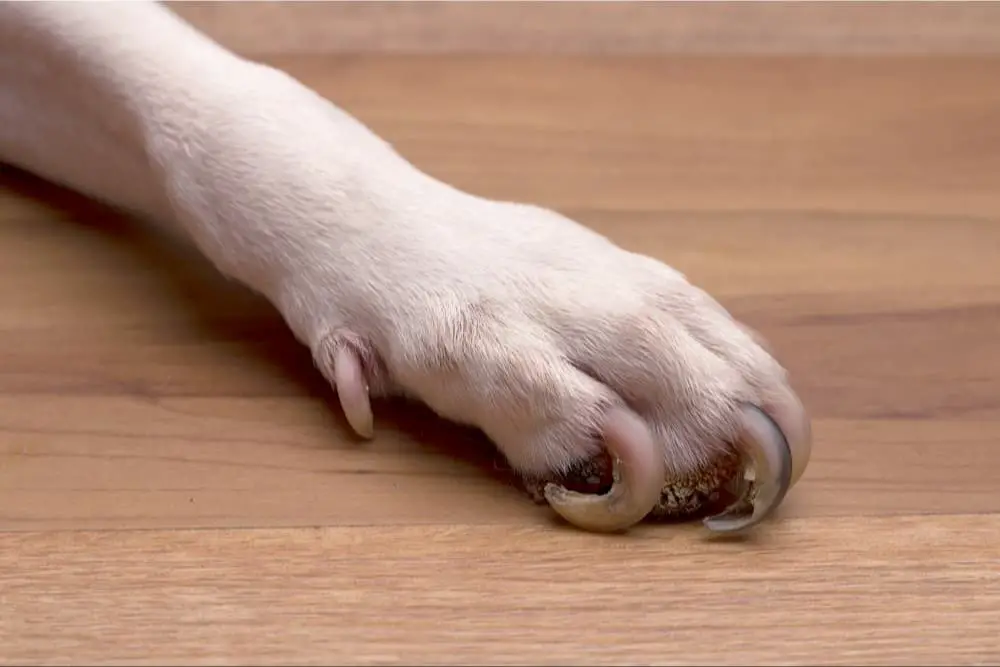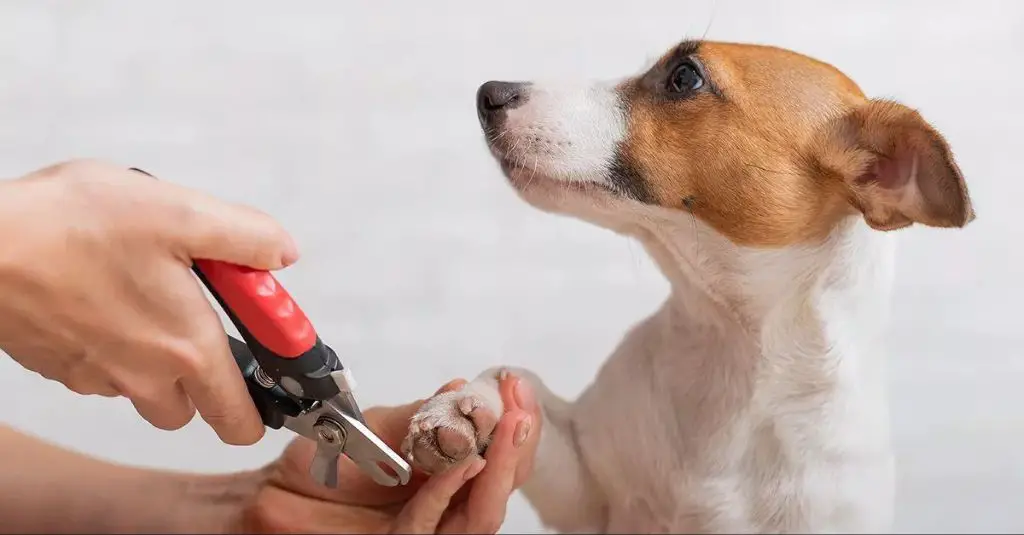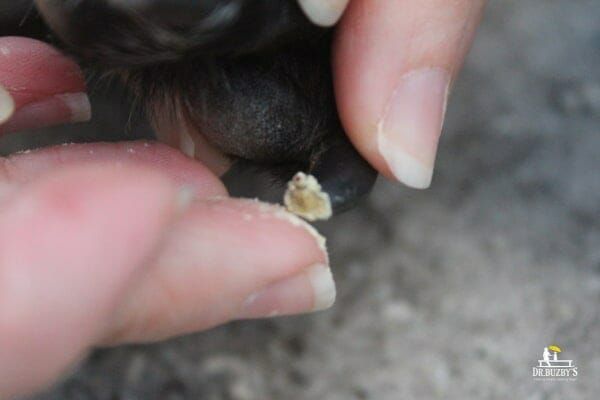Intro: Why Trimming Your Dog’s Nails Matters
Keeping your dog’s nails neatly trimmed is an important part of maintaining their health and comfort. But many dog owners worry about whether clipping their pet’s nails will hurt them. Understanding dog nail anatomy and using proper technique can help make trimming less stressful for both you and your pup.
Anatomy of Dog Nails

A dog’s nail is made up of the hard outer nail and the living inner quick. The nail consists of a hard keratinous material that protects the toe and helps give traction for walking. Inside the nail is a vein that supplies blood and nutrients to the nail root and growing cells. This vein is called the quick and contains nerves and blood vessels. The quick recedes as the nail grows longer.
The quick appears pinkish in color and ends about 2/3 down the nail. It’s important not to cut into the quick when trimming nails because it will cause bleeding and pain. The quicks in light colored nails are easier to see than in dark nails. Make sure to identify where the quick ends before trimming.
Importance of Nail Trimming
Keeping a dog’s nails trimmed is an important part of maintaining their overall foot health. Overgrown nails can lead to a variety of problems.
Long nails can get caught on surfaces while playing or running and tear off or break, causing significant pain and bleeding. Allowing the nails to grow too long can alter the way a dog’s foot meets the ground, putting strain on joints and ligaments over time. This can lead to arthritis and other orthopedic issues.
Long nails can also curl under and grow into the paw pads or twist toes in an abnormal position. Ingrown nails are extremely painful and can lead to infection. Trimming the nails helps prevent all these potential problems.
Regular nail trimming every few weeks keeps the nails short, minimizes risks of getting snagged or caught, and allows the foot to meet the ground in a natural way. This promotes overall paw, leg, and joint health. Keeping a dog’s nails the proper length is a simple way to prevent long term pain and mobility issues.
Signs Nails Need Trimming
How do you know when it’s time to trim your dog’s nails? Here are some signs that indicate it’s time for a trim:

Nails touching the floor – Long nails can cause discomfort and pain when they touch the floor as your dog walks. If you hear your dog’s nails clicking or scrapping on hard floors, the nails are too long.
Curling – Nail trimming keeps the nails short so they can grow in the right direction. If you notice your dog’s nails starting to curl under or to one side, they are too long.
Cracking – Just like human nails, dog nails can crack or split if they grow too long. Cracked nails are painful and prone to catching on things. Keep nails trimmed to avoid cracks.
Trimming overgrown nails helps ensure your dog’s comfort and prevents issues like infections, ingrown nails, and damage to floors or furniture. So keep an eye out for these signs that it’s time for a trim!
Preparing for Nail Trimming
Proper preparation is key to ensuring the nail trimming process goes smoothly and doesn’t cause any excess stress or discomfort for your dog. Here are some tips for getting ready:
Gather supplies – Have everything you need ready to go including nail clippers designed for dogs, styptic powder or corn starch (to stop bleeding if you nick the quick), treats for positive reinforcement, and a towel or mat for the dog to lay on.
Positive reinforcement – Make sure your dog associates nail trims with something positive. Give them treats and praise throughout the process. You can even start touching their paws and clipping just a tiny bit of the nail in the days leading up to reinforce that it’s a good experience.
Proper handling – For safety and cooperation, properly restrain your dog during the trim. Have someone help hold and reassure the dog. Small dogs can lay on their side on your lap or on a table. Medium or large dogs should lay on their side on the floor or ground. Keep them calm and comfortable.
Trimming Technique
When trimming your dog’s nails, it’s important to cut below the quick while removing only small amounts at a time. The quick contains nerves and blood vessels, so cutting into it will likely cause bleeding and pain. Here are some tips for proper trimming technique:

- Aim to cut just below the quick, avoiding the pinkish area where the live vein is visible.
- Trim only a small amount off the end, about 1/8 inch or less.
- If you can’t see the quick, cut conservatively and do frequent trims rather than taking off large pieces.
- Use sharp trimmers designed for dogs to ensure a clean cut.
- Cut straight across, perpendicularly to the nail.
- Take your time and don’t rush. It’s better to trim a little at a time.
- Press gently on the toe pad to expose more of the nail and quick for visibility.
Proper technique protects the quick while removing just enough of the nail to be safe and comfortable for your dog.
Does It Hurt?
The good news is that trimming your dog’s nails usually does not hurt, as long as it is done properly. The nail itself does not contain nerve endings and cannot feel pain. The only live tissue is the quick – the pinkish area where the blood vessels and nerves are.
As long as you only trim off the dead outer part of the nail and avoid hitting the quick, your dog should not feel any pain. Some dogs may feel discomfort from the pressure applied to their paws during clipping, but this is not the same as actual pain.
Signs that you are hurting your dog include whining, pulling away, and trembling. If this occurs, stop immediately and reassess your technique. Resume slowly while avoiding the quick. Some clicker training can help your dog feel more comfortable during nail trims.
Overall, while a dog’s nails do not have sensation, the quick contains nerves and cutting it will cause pain and bleeding. So proper technique is key to ensuring nail trims do not hurt your furry friend.
If You Hit the Quick
If you accidentally hit the quick while clipping your dog’s nails, it can cause minor bleeding and discomfort. The quick contains nerves and blood vessels, so hitting it can be painful for your dog. Don’t panic though – with the proper care, your dog will be just fine.

First, apply gentle pressure to the nail with a clean cloth or cotton ball. Maintain pressure for 2-5 minutes until the bleeding has stopped. You can also use styptic powder, which helps constrict blood vessels. Simply dip the nail into the styptic powder or apply it directly to the tip of the nail. This will quickly stop the bleeding.
After the bleeding has stopped, comfort your dog with praise and treats. The quick will heal on its own within a few days. Just keep an eye on the nail to ensure the bleeding doesn’t return.
Hitting the quick may make your dog more wary of nail trims in the future. Be patient, go slowly, and give lots of positive reinforcement. With time, you can help rebuild their confidence with regular, stress-free sessions.
Aftercare
After you trim your dog’s nails, it’s important to monitor them in the following days. Check the trimmed nails to make sure they are not cracked or splintered, which can happen if the nails are cut too short. Also watch for any signs of infection like redness, swelling, or pus. Your dog may try to lick its paws excessively if they are irritated.
Providing positive reinforcement after nail trimming is also key. Be sure to praise your dog, provide treats, and give them affection to create a positive association with the experience. This will make future nail trims easier. Reward-based training helps reduce any anxiety or fear around having their paws handled.
With proper technique and care, nail trims do not have to be stressful events. Being attentive to your dog’s needs and taking preventative measures will help keep their nails healthy in between professional groomings.
Conclusion
Maintaining healthy nails through regular trimming is an important part of caring for your dog. While nail clipping may seem daunting at first, with some preparation, patience, and proper technique, it can become a simple routine. Always trim just a little bit at a time to avoid hitting the quick, which contains nerves and blood vessels and would be painful for your dog. It’s also helpful to have styptic powder or cornstarch on hand. If you accidentally cut the quick, these products will stop the bleeding right away. If you stay calm through the process and make it a positive experience filled with praise and treats, regular nail trims will be a breeze for both you and your pup.
With the right tools and mindset, you can keep your dog’s nails short and comfortable between professional grooming visits. Proper nail care allows your dog to walk normally and prevents issues like ingrown nails. It’s a simple way to support their health and wellbeing. Consistent nail trimming, patience, and positive reinforcement will keep your dog’s paws healthy and happy.